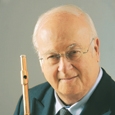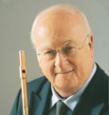The controversy over French tonguing stems from a few misunderstandings. The process, anathematic for some and indispensable for others is the procedure, indigenous to the flute, whereby the tip of the tongue shows through the lips in an attempt to obtain precise attacks and crisp articulations in staccato passages. The misunderstanding comes from some flutists, often American, who think that since the old glory days of Taffanel, Gaubert, Moyse, and Rampal, this is the only way French flutists articulate. Others, often American also, always avoid French tonguing because of American tradition or comparison to articulation on other woodwinds.
As usual the truth, if truth exists in artistic matters, lies somewhere in the middle. Why are these edicts stated in terms of always and never? There is no moral imperative. Whatever you do, if it works, keep doing it. I am reminded of something that happened to a very close friend of mine long ago. He was playing a gig with a rather pompous senior flutist who doctorally told him: "You see, mon cher, this flute is perfectly padded, it’s beautiful, and I have a new headjoint, but it doesn’t work… " The young guy replied: "You see, Monsieur, my pads don’t cover, the flute needs cleaning, it looks terrible, I got the mouthpiece at the flea market, but it works!" He was never called back to this gig.
First, let’s dispel a few myths. Is speaking French the secret of articulation? It is true that French is a more dental language than the cheeky English. However, thank God, French speakers are not the only ones who know how to articulate. It’s all in what flutists want to hear. If they want a crisp, light staccato and a precise attack, there are solutions for that. If they like a barely separated legato,1 they can learn that too.
Second, there are many varieties of French, French vanilla, French dressing, French fries, most of which do not exist in France. France has everything that America has: judges who cheat at the Olympics and C.E.O.s who defraud their employees, flutists who like to be crisp, and others who can’t articulate. Let’s not put people into little categories.
Third, I was never taught to show my tongue on every played note, fast or slow. My late colleague Alain Marion used such a device for practice, but I don’t recall him using this technique except for the onset of a phrase, as I will try to explain.
When French youngsters start the flute, one of the first things they learn is how to tongue each slow attack as if spitting out a tea leaf or a fig seed. This action is the basis of French tonguing. Too many theoretical explanations turn students off. For very young students, without thinking, this type of articulation provides a good air speed, a good placement of the airbrush,2 and a natural embouchure. Eventually, when the time is right, vibrato spontaneously follows the fig seed effect.
So I agree that French tonguing is impractical and ill-advised for repeated notes. At the onset of a phrase, such as the start of Faure’s Fantaisie Op. 79 or the first high F in Poulenc’s Cantilena, at the attack of long notes in countless orchestral works, it is extremely useful if done right.
Let me digress a moment to a seemingly unmusical comparison with the internal combustion engine that propels most of our rolling stock. During each cycle the valves control the intake of air/fuel mixture and allow exhaust gasses to exit at the appropriate times. The valves have no other function than to open or close an opening. "It must be remembered that the tongue is simply a kind of spring valve that contains and releases the appropriate impulse of pressure of air behind it … "3 If for some reason the valve does not close well, the action of the engine is jeopardized. In French tonguing, the tongue acts like a valve. Just before the attack the tongue closes the aperture of a volume where air is under pressure (support). When the tongue is swiftly pulled back, the air column pressure becomes air speed, without percussion.
The principle of the organ pipe is more musical and closer to us. Organs have a wind chest, just as we do, that is full of air under pressure, ready to go to the pipes. When the key is depressed, a valve opens beneath the pipe so the wind can finally get through to the pipe. If the valve is open before the wind chest is under pressure, the sound of squeezed teddy bear results. If air is released without first stopping the pipe, the sound comes too soon for a controlled attack.
If the tongue is still back in the mouth at the onset, the tongue has to travel to the teeth to articulate, and pressure build-up becomes problematic because the aperture is not stopped. A common misconception about French tonguing is the perception that the tongue moves from back to front, but instead the tongue’s movement is a simple venting of an aperture from front to back.
It can be useful to blow a little bit of air through the nose just before release to set air in motion, and prevent an explosive onset, just like strings’ bows move before a smooth attack.
There is no religion about this. If another way works, by all means keep doing it. After all, what you do with your tongue is nobody’s business.
—–
1 Literally legato means tied. It is not supposed to describe the da-da-da, which is the antinomy of both slurring and staccato.
2The short and narrow stream of air linking the lip aperture to the breaking edge of the lip plate.
3William Kincaid in Kincaidiana by John Krell (page 18).






